 |
Promenade into History — Old Seoul Architecture III |
 |
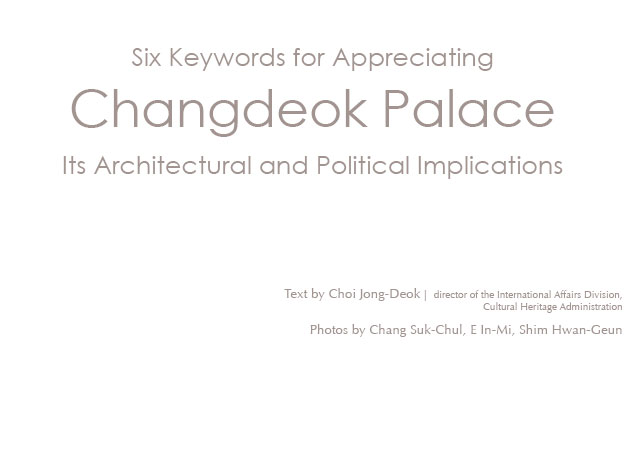 |
 |
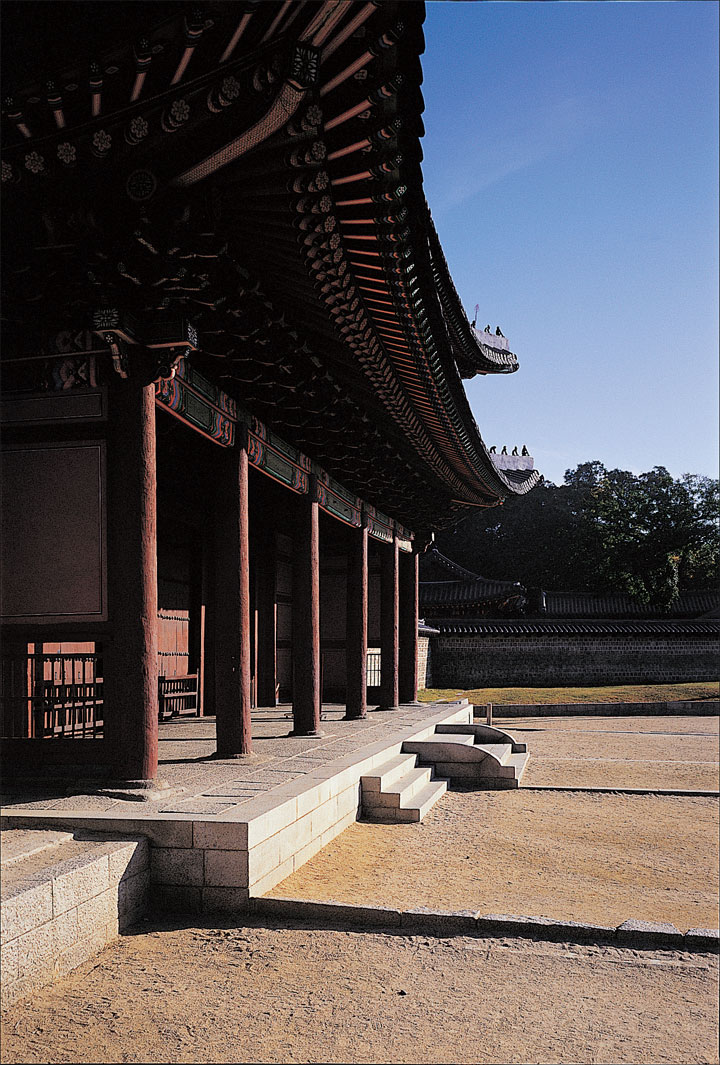 |
| 1.Donhwamun,the main gate of Changdeok Palace |
 |
 |
 |
 |
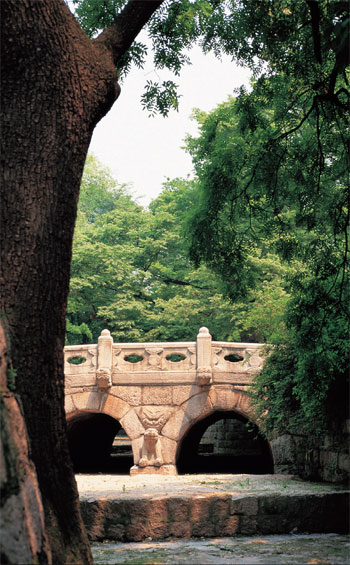
2. Geumcheongyo, the bridge over the Forbidden Stream in Changdeok Palace
|
 |
A palace was a grand residence of the king and the seat of government as well as a supreme symbol
of the dynasty. Hence it contained the values and thoughts of its era. A palace may therefore seem like an architectural labyrinth with inextricable
meanings, but once the key points have been grasped, it is not so difficult to understand its apparently complex symbolism. For better understanding of the symbolism of Changdeok Palace, one of the royal palaces of the Joseon Dynasty (1392-1910), let us take a walk around its compounds with six vital keywords in mind.
Changdeok Palace lost much of its original appearance
during the colonial period (1910-1945). The palace has regained its old grandeur to a remarkable
degree through a restoration project under way since the 1990s. Through several rounds of rehabilitation
after its completion in 1405, the palace maintained
its original arrangement of structures, that are "carefully integrated into and harmonized with the natural setting," as recognized by the UNESCO World Heritage Committee upon its inscription on the World Heritage List.
|
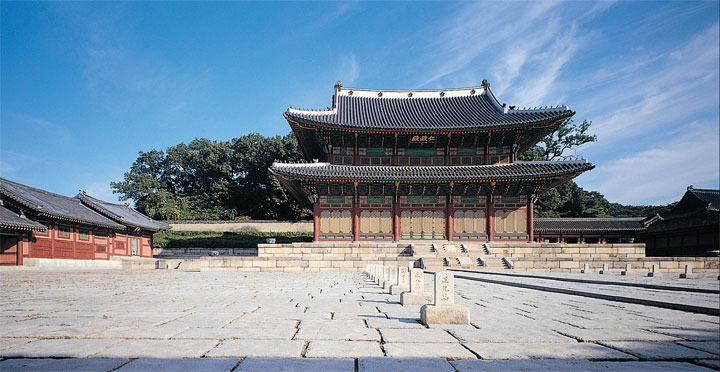
3. Injeongjeon, the Throne Hall in Changdeok Palace
|
Mountain at the Back and Water in the Front
According to the traditional theory of pungsu (feng shui), an ideal place for human abode, whether alive or dead, should have mountains
at the back and face a river in the front. Changdeok Palace is situated with the Maebong
peak of Mt. Bugak to the rear and a manmade
stream flowing through its outer courtyard.
Thus the palace grounds were intended to be blessed with positive energy flowing from the mountain and guarded by the stream chasing
away evil spirits. The stream was called geumcheon, meaning the "forbidden stream," and the stone bridge over it geumcheongyo. The bridge is carved with designs of imaginary animals believed to be capable of fending off evil spirits.
Front Court and Rear Residence
Under the influence of ancient Chinese rule of palatial layout, the palace has government offices in the outer court and the private residence
of the royal family in the inner quarters. The front court has offices for courtiers, the offices
of the king(Seonjeongjeon, or the Hall of Promoting Governance), and the throne hall
|
 |
(Injeongjeon, or the Hall of Benevolent Governance),
where official events and ceremonies were held. At the rear of these structures are the residences of the king and the queen-Hijeongdang
(Pavilion of Joyous Governance) and Daejojeon (Hall of Great Creation)-and more buildings where other members of the royal family lived.
Royal Palace Behind Nine Gates
Traditionally, the palace where the king resided was called gujung-gunggwol, meaning the "palace
surrounded with nine layers of buildings." The figure "nine" here is more symbolic than numerical, indicating the perfect security of the royal residence. Accordingly, Seonjeongjeon, the offices of the king, and Hijeongdang, the royal bedchamber, were situated in the innermost
quarters of the palace surrounded by multiple
layers of structures.
The structures standing in front of the king's offices and residence halls provided both safety and convenience of the king. All of them were removed during the colonial period. They included
the offices of security officers, official chroniclers and eunuchs. The security officers guarded the king around the clock and conveyed orders for troop mobilization at emergency
situations. The official chroniclers recorded the words and actions of the king for basic material for history compilation in later years. These aides-de-camp to the king served the king at the nearest distance. Eunuchs supervised
food, delivered orders, guarded gates and cleaned the palace.
|
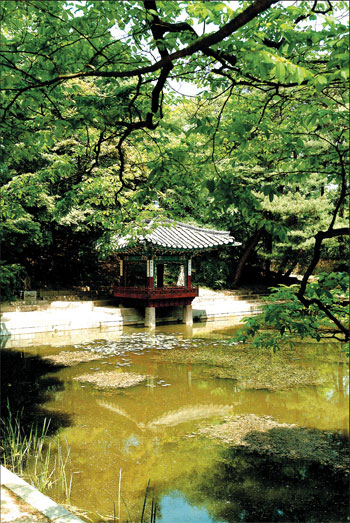
4. Aeryeonjeong, the pavilion at the pond in the Secret
Garden of Changdeok Palace
|
 |
East Palace for the Crown Prince
The eastern section of the palace was traditionally
reserved for the crown prince. As heir to the throne the crown prince resided in the East Palace, symbolizing his status as"the sun before
rising." Changdeok Palace had the crown prince' s palace, Junghidang (Hall of Immense Joy), located to the east of the king's offices and bedchamber. King Jeongjo built the hall in 1782, the sixth year of his reign, when he had his first son and wrote its name sign himself. He conducted the investiture ceremony for his three-year-old son at the palace and named him Crown Prince Munhyo.
Various scientific tools, including a sundial, a rain gauge, a wind streamer and an armillary sphere were installed on the grounds of the crown prince' s palace. They were not only use1 ful for measuring time and weather for practical purposes like helping the farmers, but they carried
symbolic significance for the ruler's power in a society worshiping heaven. They were also used for the crown prince's education.
Junghidang was destroyed during the reign of King Gojong toward the end of the dynasty and its site is now the main road leading up to the Secret Garden. A few small pavilions in unique shapes, named Seunghwaru and Iguwa, and part of a cloister connecting them, named Chilbunseo, are all that remain of the crown prince's palace today.
|
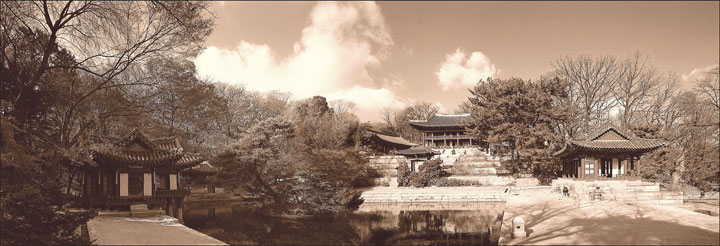
5.Juhamnu, the Pavilion of Cosmic Union
|
East Court for the Queen Dowager
The queen dowager's residence was also located in the eastern section of the palace. Upon getting a concubine in 1847, the 13th year of his reign, King Heonjong built Nakseonjae (House of Joy and Goodness) in the southeastern
part of Changdeok Palace for his residence. The next year he built Seokbokheon (House of Frugal Happiness) for his concubine, Lady Kim, to the east of Nakseonjae, and then Sugangjae (House of Health and Longevity) for his grandmother, Queen Dowager Sunwon, further to the east. The three structures stand side by side with the queen dowager's residence located
at the eastern end.
|
|
Round Heaven and Square Earth
Juhamnu, or the Pavilion of Cosmic Union, looking over the Lotus Pond in the Secret Garden
of Changdeok Palace, was constructed in 1776, the year King Jeongjo ascended the throne. The two-story pavilion and the pond create exquisite scenery. Jeongjo opened Gyujanggak, the Royal Library, on the first floor of the pavilion where eminent scholars engaged in academic research to promote civil rule. He named the pavilion Juhamnu, symbolizing the harmony of heaven and earth and the four cardinal
directions, and wrote the sign himself. Buyongji, the square pond with a round islet, visualizes the ancient cosmic view that heaven is round and the earth is square.
|
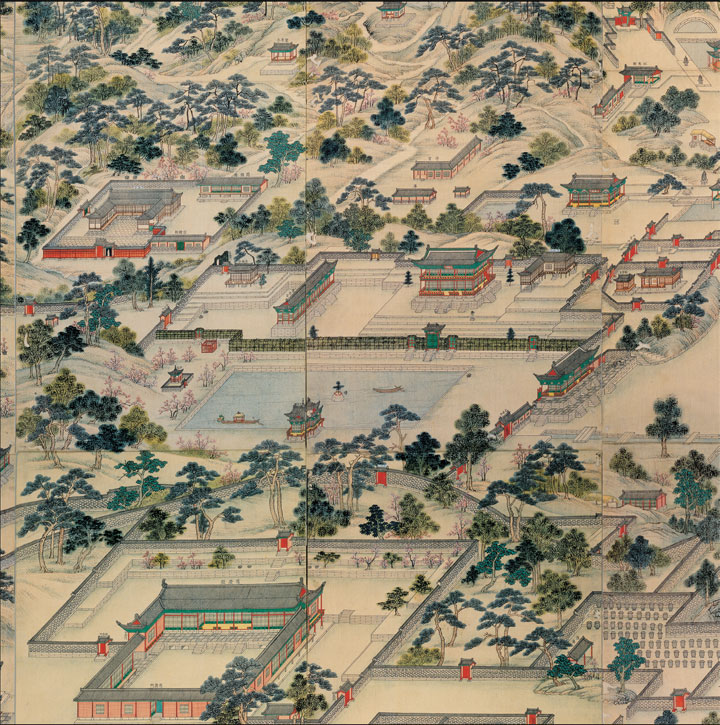
|
6.Juhamnu depicted in Donggwoldo (a court painting that shows an appearance of Changdeok Palace of the Joseon Dynasty in the late 1820s)
|
|
 |


